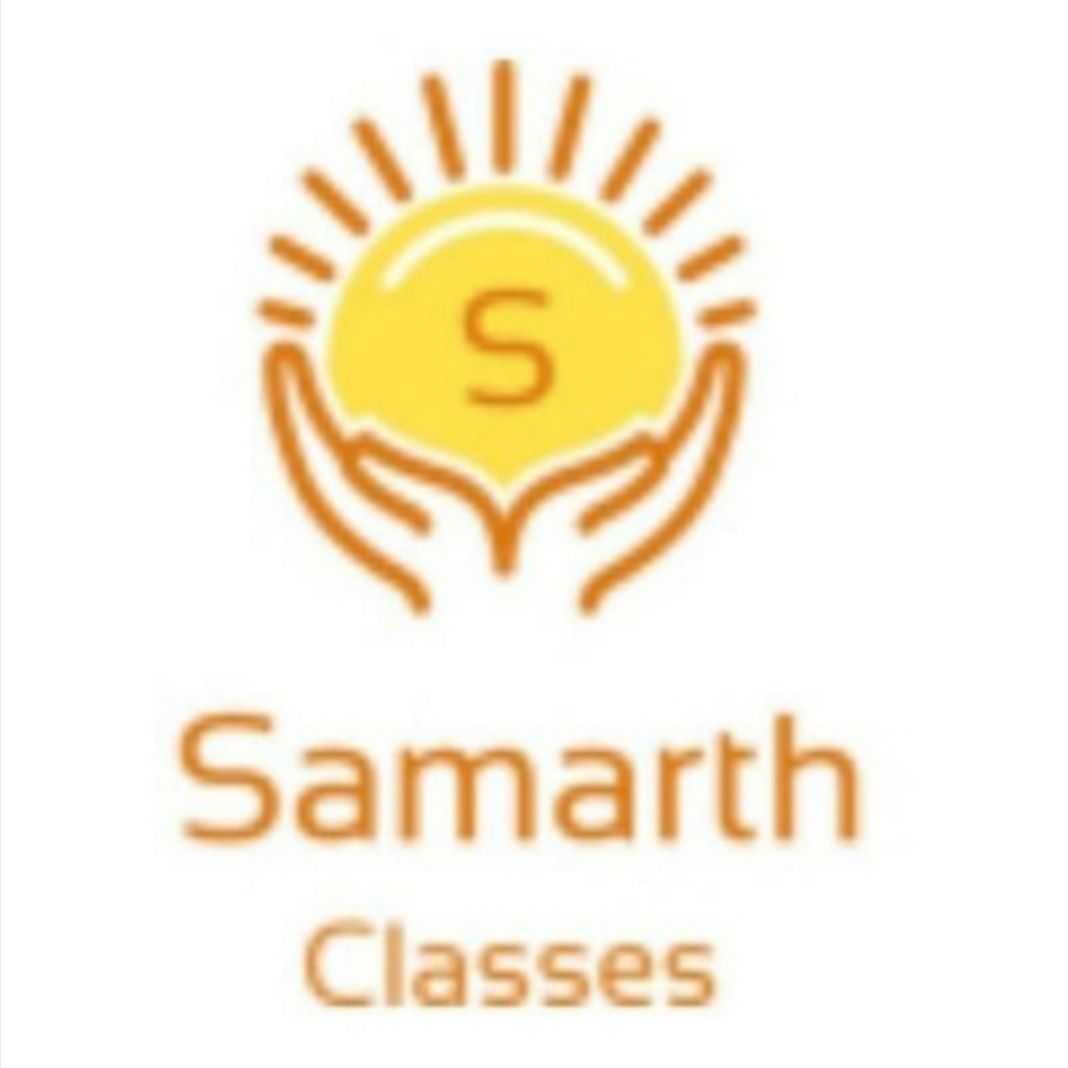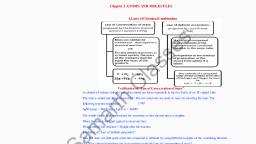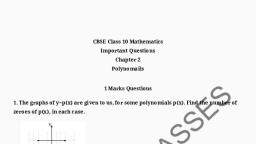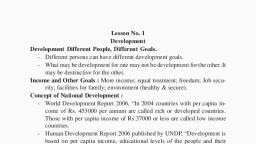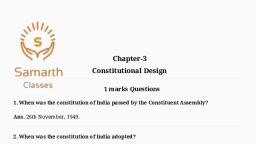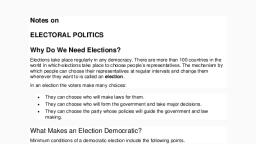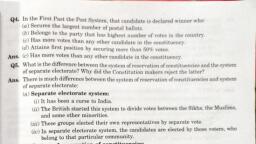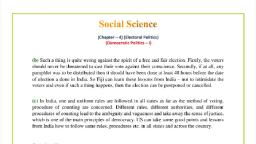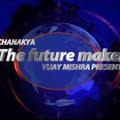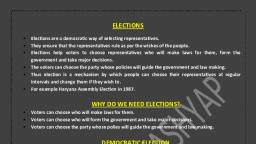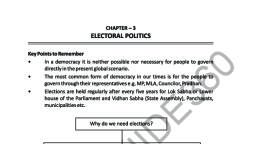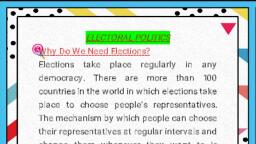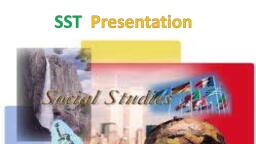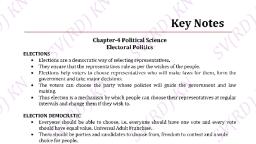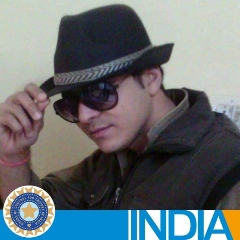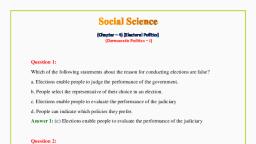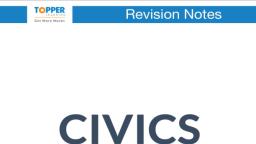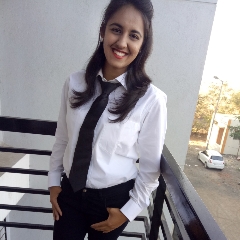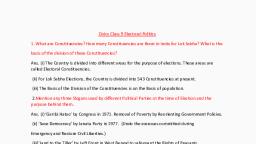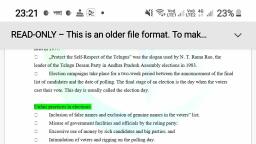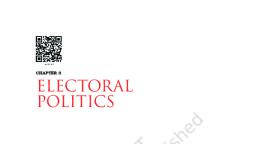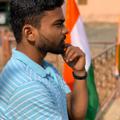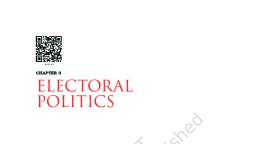Page 1 :
Chapter 3, Electoral Politics, Election, It is a process through which people chose their representatives in a democracy after, a specified period., An election helps a voter make choices such as –, Choose who will form the government and take the policy decisions., Choose the party whose policies will direct the government., Choose who will prepare laws for the people., Need for Elections, For choosing people‟s representatives., For changing the representatives or the government., What Makes an Election Democratic?, Elections give the right to choose to every adult citizen. Everyone has one, vote and each vote has one value., Every citizen can contest elections., Regular elections after every few years ensure that each political party is put to, test. If the government fails to perform, another political party gets the chance of, forming the government by winning elections., Free and fair elections and the provision of secret ballot., Demerits of Political Competition, It has demerits such as jeopardising the unity of the nation and creating, „factionalism‟ in the society., Candidates and parties use dirty methods for winning elections., People who want to serve the country avoid entering this field owing to, unhealthy competition., Our System of Elections, The Lok Sabha and the Vidhan Sabha elections are held in India every 5, years., The Lok Sabha election is called the General Election., There are certain elections that are conducted in a particular constituency owing to the, death/ resignation of a member. These are called by-elections., Electoral Constituencies
Page 2 :
The country is divided into electoral constituencies for both the, Lok Sabha and the Legislative Assembly elections. One, representative is elected from each constituency by the voters., The country is divided into 543 constituencies for the Lok, Sabha elections. The selected representative is called the, Member of Parliament or MP., Similarly, each state is divided into a number of Assembly constituencies, and the representative selected from each constituency is called the, Member of Legislative Assembly or MLA., Reserved Constituencies, In open electoral competitions, certain weaker sections of the society, may not stand a good chance of winning because of the influence, of powerful sections. Hence, the makers of our Constitution, prepared a system of reserved constituencies for these, weaker sections., Certain constituencies are reserved for the people belonging to the, Scheduled Castes (SC) and the Scheduled Tribes (ST)., In the Lok Sabha, seats reserved for the SCs and STs are 84 and, 47 respectively. These are in proportion to their population in, the total population of the country., Seats are reserved for the Other Backward Classes (OBC) as well., Voter’s List, The list of people who are eligible for voting is prepared by the, Election Commission of India., This ensures that everyone in the country gets an equal, opportunity of choosing their political representatives., Regardless of a person‟s caste, creed, colour and gender, every citizen of, and above 18 years of age is eligible to vote., Eligibility for Contesting Elections, An Indian citizen., Age should be minimum 25 years., There are restrictions on people with criminal records, but, those are extreme cases., The candidate has to fill a „nomination form‟ and give a, „security deposit‟.
Page 3 :
, , , , , , , , Also, a legal declaration has to be made with details of pending, criminal cases against the candidate, assets and liabilities of the, candidate and the educational qualifications of the candidate., Election Campaign, Election campaigns in India takes place for two weeks, starting from the, declaration of the final list of candidates contesting the elections, and concluding 48 hours before the date of polling., During this campaign, candidates reach out to the voters. Political leaders, hold election meetings and rallies for informing the voters about, their policies and persuading them to vote for them., Some successful slogans used during campaigns are “Garibi Hatao”, (used by the Congress, led by Indira Gandhi, in the year 1971), “Save, Democracy” (used by Janata party in 1977), “Land to the Tiller’ (used by, The Left Front in West Bengal Assembly elections, 1977), etc., No party/candidate can–, Bribe/threaten the voters., Influence the voters in the name of religion., Use government resources for campaigning., Expend more than 25 lakhs for the Lok Sabha elections and 10, lakhs for the Assembly elections., According to the Model Code of Conduct, no party/candidate, can–, Hold election propaganda in places of worship, Use government aircrafts and vehicles, government officials, etc., On the announcement of elections, ministers cannot take policy decisions, or start any big projects., Polling and Counting of votes, A person, with his name on the voter‟s list can go to a polling, booth, get identified by the officials, get the mark on his finger, and, caste the vote for the candidate of his choice., Agents of the candidates are permitted to be seated inside the, polling booths for ensuring that a fair voting takes place., Electronic Voting Machines (EVMs) are used for casting votes instead of, the ballot paper., Counting of votes begin after few days of election.
Page 4 :
What Makes Elections in India Democratic?, Independent Election Commission, In India, elections are conducted by the Election Commission (EC)., It is an autonomous body, independent of any governmental, control., The President of India appoints the Chief Election Commission, (CEC). The CEC is neither answerable to the government nor to the, President., EC takes all decisions related to elections. It declares the election, dates and also the results., The EC has the power of punishing those candidates/parties who, violate the Code of Conduct., During elections, the EC sets guidelines for the government, so, that government‟s powers are not misused for winning, elections., The government officials, who are on election duty, work under the, EC, and not the government., Popular Participation, Voter turnout figures determine the extent of people‟s participation in, the elections. Compared to North America and Europe where the, turnout has declined over the last 50 years, the figures for India, either stayed stable or increased., Compared to the USA where the richer and the white people vote, the most, in India the majority of the voters are the poor,, underprivileged and the illiterate people., Acceptance of election outcome, If elections are not free/fair, it favours the powerful/ruling party., Ruling parties lose elections in India routinely, both in the states and the, national level., Half of the sitting MPs and MLAs lose elections in India. This shows, that the India voters are well aware of the functioning of the, government and do not re-elect those representatives that fail in, fulfilling their promises., Candidates with money and muscle power often lose elections., The outcome of the elections are normally accepted by the defeated, party as the “people‟s verdict”., , Challenges to Free and Fair Elections
Page 5 :
Candidates with excessive money enjoy an unfair advantage over smaller, parties/candidates., Candidates with criminal records dominate others and remove them from the, electoral race by using coercion., Some political parties are dominated by families who try to distribute tickets, only to their relatives and family., Small parties suffer huge setbacks as compared to big parties., Because of the above reasons, many organizations and activists have, been demanding a reformed electoral system.
